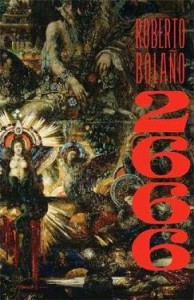 Roberto Bolaño’s opus 2666 is expansive and ambitious, even by the standards of his earlier The Savage Detectives, and manages to exceed its predecesor in the ominous sense of foreboding that pervades the chaos and entropy of his worlds. This is a novel on an international scale, spanning countries, continents and generations, whose narrative and thematic center is Santa Teresa, a fictionalized Ciudad Juarez, a Mexican border city where some 300 women and young girls have been violently killed over the course of a decade, and that acts as a black hole silently compelling the various protagonists to converge there.
Roberto Bolaño’s opus 2666 is expansive and ambitious, even by the standards of his earlier The Savage Detectives, and manages to exceed its predecesor in the ominous sense of foreboding that pervades the chaos and entropy of his worlds. This is a novel on an international scale, spanning countries, continents and generations, whose narrative and thematic center is Santa Teresa, a fictionalized Ciudad Juarez, a Mexican border city where some 300 women and young girls have been violently killed over the course of a decade, and that acts as a black hole silently compelling the various protagonists to converge there.
I was horrified to learn that the murders are not fictive, and equally horrified to think that such atrocities could be committed with scant international attention. According to Amnesty International, between 1993 and 2005 almost 400 women, many as young as ten years old, have been violently killed in Ciudad Juarez, frequently after suffering abduction, torture, rape or dismemberment. Thus far the Mexican government has proven incapable, inept or unwilling to protect its own citizens from the ravages of the drug trade, and one gets the sense, reading Bolaño’s relentless and pitilessly detailed accounts of each successive murder, that part of his design is to educate, even castigate, his readers out of their (our) apathy.
And yet there is also something apocalyptic about the novel, a resignation that the point of no return may have been reached, even long passed, and what is left is the inexorable decline, the murders merely symptomatic of a larger human tendency towards destruction, climaxing in one character’s experiences with the Holocaust, told in a retrospective, and epitomized by the novel’s mysterious title, evokative, perhaps, of a date – the year 2666 – and the religious symbols of apocalypse and antichrist represented by the number of the beast: 666.
For all its foreboding, however, there is humor and lightheartedness and an abundance of humanity in all its petty foibles. The novel’s opening section, “The Part About the Critics,” begins by recounting the adventures of a group of literature professors hunting for a reclusive German writer and falling in and out love with one another but, just as the intricacies of their various affairs threaten to captivate his reader, Bolaño abruptly ends their narrative and they recede, permanently, into the story’s background as the darker designs of the writer begin to unfold.
Those familiar with Bolaño will recognize this as a characteristic trait of his writing: he loves to tantalize his readers with possibility before dashing their hopes and cutting a narrative, or narrator, short. In 2666, as in The Savage Detectives, he delights in making familiar characters and story lines disappear, creating expectations in his reader that he will often refuse to meet with casual insouciance. The result is a novel massive in scope, cobbled together from disparate and tangentially related narratives and yet thematically concise, a fitting capstone to the works of a writer whose entire short life was spent in service of his art.